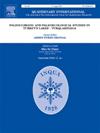12.8-4.7 ka期间东赤道印度洋上层水柱结构的变化
IF 1.8
3区 地球科学
Q3 GEOGRAPHY, PHYSICAL
引用次数: 0
摘要
东赤道印度洋(EEIO)是印度洋-太平洋暖池的关键区域,在调节区域和全球气候方面发挥着至关重要的作用。其复杂的水文主要受多种海洋和大气过程的相互作用影响,即海洋间热交换(印度尼西亚通流;ITF),海洋-大气相互作用(印度洋偶极子;IOD和El Niño-Southern振荡;ENSO)和季节性季风环流,在不同的时间尺度。然而,这些气候成分的相关反馈和对EEIO水文在千年时间尺度上的影响仍不清楚,因此突出了进一步研究的必要性。在此,我们给出了在EEIO特定位置(8.40°S, 98.00°E)的SC-04B铁铲岩芯上的浮游有孔虫代用物(% Globigerina bulloides, %共生-贫生和共生物种)和稳定氧同位素(Globigerinoides ruber (r)和Pulleniatina obliquiloculata (o)和Δδ18Or-o)在百万年至千年尺度上的良好记录。岩心跨度为晚冰期至全新世中期(12.8-4.7 ka)。利用区系和同位素指标重建了12.8-4.7 ka期间的地表水文、生产力和上层水柱结构的变化,并探讨了它们与ITF、iod样平均状态和南亚季风(SAM)变率的潜在联系。我们记录了地表ITF在12.8至~ 9.8 ka期间的影响增加,并在~ 9.8至4.7 ka期间转换为温跃层ITF。与现有的印度洋和邻近大陆的海洋和陆地古气候记录相比,我们的动物代用指标表明,东南季风和上升流在12-9.2、8.0-7.3、6.4-5.6和5.2-4.7 ka期间增强。这些时间间隔对应的条件类似于热带印度洋的正IOD (pIOD)样平均状态,此时SAM也增强了。而在12.8-12、9.2-8.0、7.3-6.4和5.6-5.2 ka,减弱的东南季风导致降水引起的分层增加,形成类似于负IOD (nIOD)平均状态的地表条件,抑制了EEIO的地表生产力。此外,我们记录了4个不同的间隔(~ 6、~ 8.2、~ 10.5和~ 12 ka)低% G. bulloides丰度和相应的Δδ18Or-o低值,这似乎与北大西洋的寒冷阶段一致[Bond Events (BEs) 4、5、7和Younger Dryas (YD)]。我们认为这些变化可能与西北季风的增强有关,并可能通过大气遥相关受到北大西洋冷事件的调节。本文章由计算机程序翻译,如有差异,请以英文原文为准。
Changes in the upper water-column structure of the eastern equatorial Indian Ocean during 12.8–4.7 ka
The eastern equatorial Indian Ocean (EEIO), a pivotal region of the Indo-Pacific Warm Pool, plays a crucial role in modulating both the regional and global climate. Its complex hydrography is mainly influenced by an interplay of multiple ocean and atmospheric processes, i.e., inter-oceanic heat exchange (Indonesian throughflow; ITF), ocean-atmosphere interactions (Indian Ocean Dipole; IOD and El Niño-Southern Oscillation; ENSO) and seasonal monsoon circulations, at varying time-scales. However, the associated feedbacks of these climatic components and the impact on EEIO hydrography over millennial time-scales remain unclear, thus highlighting the need for further investigation. Here, we present well-dated records of the planktic foraminiferal proxies (% Globigerina bulloides, % symbiont-barren and symbiont-bearing species) and stable oxygen isotope (δ18O of Globigerinoides ruber (r) and Pulleniatina obliquiloculata (o), and Δδ18Or-o) at multi-centennial to millennial scale resolutions from a spade core SC-04B, retrieved from a specific location of the EEIO (8.40°S, 98.00°E). The core spans the late deglacial to middle Holocene period (12.8–4.7 ka). Using faunal and isotope proxies, we reconstructed changes in surface hydrography, productivity, and the upper water-column structure during 12.8–4.7 ka, and explored their potential links with the ITF, IOD-like mean state, and South Asian Monsoon (SAM) variability. We document the increased influence of surface ITF during 12.8 to ∼9.8 ka that switched to thermocline ITF during ∼9.8 to 4.7 ka. When compared with existing oceanic and land-based paleoclimate records from the Indian Ocean and adjacent continents, our faunal proxies suggest an intensification of the southeast (SE) monsoon winds and upwelling-induced surface productivity in the EEIO during the periods of 12–9.2, 8.0–7.3, 6.4–5.6, and 5.2–4.7 ka. These intervals correspond to conditions similar to a positive IOD (pIOD)-like mean state in the tropical Indian Ocean, when SAM was also intensified. In contrast, during 12.8–12, 9.2–8.0, 7.3–6.4, and 5.6–5.2 ka, weakened SE monsoon winds led to increased precipitation-induced stratification, creating surface conditions similar to a negative IOD (nIOD)-like mean state, which suppressed surface productivity in the EEIO. Further, we record four distinct intervals (∼6, ∼8.2, ∼10.5, and ∼12 ka) of low % G. bulloides abundance and corresponding low values of Δδ18Or-o, which appear to coincide with the cold phases in the North Atlantic [Bond Events (BEs) 4, 5, 7 and Younger Dryas (YD)]. We think that these changes were possibly linked with the intensified northwest (NW) monsoon winds and could have been modulated by the North Atlantic cold events potentially through atmospheric teleconnections.
求助全文
通过发布文献求助,成功后即可免费获取论文全文。
去求助
来源期刊

Quaternary International
地学-地球科学综合
CiteScore
5.60
自引率
4.50%
发文量
336
审稿时长
3 months
期刊介绍:
Quaternary International is the official journal of the International Union for Quaternary Research. The objectives are to publish a high quality scientific journal under the auspices of the premier Quaternary association that reflects the interdisciplinary nature of INQUA and records recent advances in Quaternary science that appeal to a wide audience.
This series will encompass all the full spectrum of the physical and natural sciences that are commonly employed in solving Quaternary problems. The policy is to publish peer refereed collected research papers from symposia, workshops and meetings sponsored by INQUA. In addition, other organizations may request publication of their collected works pertaining to the Quaternary.
 求助内容:
求助内容: 应助结果提醒方式:
应助结果提醒方式:


